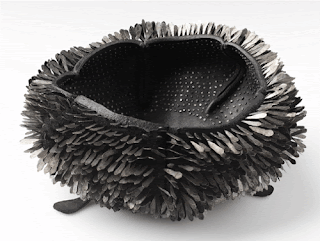In many ways when you think about the work that you make, and you start rifling through the catalogues of your work, there is quite a bit there that is counter intuitive there in regard to your materials and their ‘placedness’.
One supposes in Tasmania that “wood” might form an important part of the materials larder for a ‘maker’ like yourself.
Instead, we find that you are an eclectic maker who uses a lot of different material and not so often wood. In fact there seems to be some kind of antithesis here. Is there?
Since we are talking about the place of ‘place’ in cultural production, and the making of things, your use of metal seems to pose a few questions. For instance, for whatever reason, and it is refreshing to see, you do not seem to pay homage to a particular metal technology, say like one of the ‘smithings’ – black, tin, copper, whatever.
From the little you tell us about your childhood visiting relatives living in isolation from town, does metal, or any other material figure in those kind of memories. That is, the kind of memories that subliminally pop up from memory, and that provide solutions, or perhaps even giving a permission to do things in some way.
Traditions are often 'place centred'. For instance, maker in a particular place traditionally, or is it habitually, use particular material in particular ways. You seem to be inventing or invoking you own kind of traditions and technologies.
Sally: Tasmania is well and truly branded and perceived as an island of wood and woodworkers. When I am introduced to someone as a Tasmanian designer-maker, there is an immediate assumption that I make lots of tables and chairs out of native special timbers. I have hardly made any tables or chairs and very rarely use special timbers, or much timber at all.
I was surprised and pleased recently to be invited to take part in an exhibition which will focus on Tasmanian metalworkers for a change. Of course woodworking is perfectly valid and it stands to reason that a place renowned for this beautiful natural resource would produce craftspeople skilled in using it. Indeed Tasmania seems to attract fine woodworkers in a kind of cultural exchange, replacing those interested in industrial or product design who leave for mainland cities.
When I began my studies in Furniture Design at university I suppose I too assumed I would pop out the other end of the course and become another woodworking designer-maker. The truth is, I really don’t like woodwork. I also don’t like the look of the special timbers; I find a lot if it far too gaudy, especially highly figured and coloured timber.
I also happen to really, really like working with metal. I love the strength, durability and malleability of metal. I love the way it feels to work with and the enormous creative potential it offers. I have used a lot of different materials in my practice but looking back I can see it has been a process of elimination; a search for the right medium.
I have fiddled about with wood, plastics, fibreglass and lots of fibre and fabric before realising that my passion is for metal. I still incorporate other materials into my work, but usually in a supporting role, as a means to an end, such as the ‘stone’ bowls shown above; there is a wooden substrate to give the bowls a nice solid feel, and to provide something to nail into.
I also ‘borrow’ techniques and ideas from other disciplines. I have come to realise that my long held passion for fibre and textiles is about technique, not material. I frequently use these and other techniques, unconventionally, with metal. Gradually, over about 10 years, I have more or less abandoned woodwork and now define myself as a metalworker.
Antithesis? Not on any deliberate, conscious level. It is simply a matter of preference. But why? Why would someone from the Land of Wood have a preference for metal? I suspect it does come ultimately from my upbringing and family.
Tasmania(indeed Australia), is also the land of two other things of significance; mining, and ‘Making Do’. Ingenuity and the ability to ‘make do’ with whatever is to hand is seen as a quintessentially Australian trait; ingenuity born of necessity.
These days we call it ‘thinking outside the square’, and mostly leave it to ‘designers’, probably because the essential ingredient of necessity has been more or less removed.
My grandfather was an engineer, and operated a small alluvial tin mine in a remote part of Tasmania. He often worked alone. He had to rely on his ingenuity, making do with whatever was available for repairs and maintenance both of the mining equipment and general requirements of a remote existence. I greatly admire this particular brand of ingenuity/problem solving, and I guess it was significant in my upbringing.
I have never been formally trained in any specific technical discipline, which is perhaps why I don’t adhere to one. I have never learnt the ‘rules’ so I don’t feel bound to follow them. I learn various techniques as I need them or as they interest me, and add them to my eclectic set of skills.
I experiment. I use a variety of metals in a lot of different forms, often salvaged. An array of materials demands an array of techniques. I invent my own way of doing things, with whatever materials I have to hand and whatever skills I have, just like my grandfather did. It seems to me that in a way I am following place centred traditions, just not the woodworking tradition that is apparently expected of me.
Rather, I follow a family tradition, or a rural and remote tradition, of working creatively with the materials that are available.







